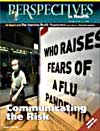Bird Flu:
Communicating the Risk
(Page 5)
Here are some other recommendations in brief:
6. Be willing to speculate—responsibly
Warnings are intrinsically speculations. Like hurricane forecasters, we have to offer both worst-case scenarios and likelier scenarios, always acknowledging that we may turn out to be wrong.
7. Don't get caught in the numbers game
Battles over how many people an H5N1 pandemic might kill are pointless. What matters is that flu pandemics are horrific, and for the first time ever we can see one coming and start getting ready.
8. Stress magnitude more than probability
The rationale for H5N1 pandemic preparedness isn't that we're sure it's coming, but how bad it could get. Overconfidence about risk probability is a mistake. Dramatic warnings about risk magnitude are more justified. (There are times when it's best to stress probability. But the uncertain prospect of a catastrophe should be about magnitude.)
9. Guide the adjustment reaction
Once people get past their apathy and start taking a new risk seriously, the normal response is an "adjustment reaction"—a temporary fearfulness, sometimes accompanied by misplaced or excessive caution. This is the teachable moment. Don't ignore it or ridicule it; guide it. Then we settle into the "new normal."
10. Inform the public early and aim for total candor and transparency
These are two of the hardest risk communication recommendations for governments to adopt. There are so many barriers-fear of damaging the economy, looking incompetent, turning out to be wrong, causing undue alarm. But the price of informing the public late, of covering up or minimizing the problem, is high: diminished credibility, just when you need it most to help your people through an influenza pandemic.
Most of these recommendations are counterintuitive. That's the toughest thing about risk communication: it contradicts what comes naturally to most authorities, especially when they're under pressure. And risk communication is itself an uncertain field. We think it improves the odds of a good outcome, but we can't guarantee a good outcome every time. Health authorities face tough choices as they plan how to talk to people about a possible flu pandemic, and one of those choices is: how much to let risk communication guide their choices.
Peter M. Sandman, Ph.D., and Jody Lanard,M.D., are risk communication consultants based in
Princeton, N.J., USA. See www.psandman.com.
An interactive, self-taught course on risk communication is available at the website of the Pan American Center for Sanitary Engineering and Environmental Sciences (CEPIS), one of 10 scientific and technical centers of the Pan American Health Organization (PAHO). The course covers the theory and methodology of risk communication and discusses strategies and effective interventions for target populations. It was developed by PAHO and the U.S. Agency for Toxic Substances and Disease Registry (ATSDR) with support from the U.S. Centers for Disease Control and Prevention (CDC). Students who finish the course successfully receive a certificate of completion. The course is available in English, Spanish, and Portuguese at www.bvsde.ops-oms.org/tutorial6/i/index.html.

![]() PDF Version (2.7Mb)
PDF Version (2.7Mb)